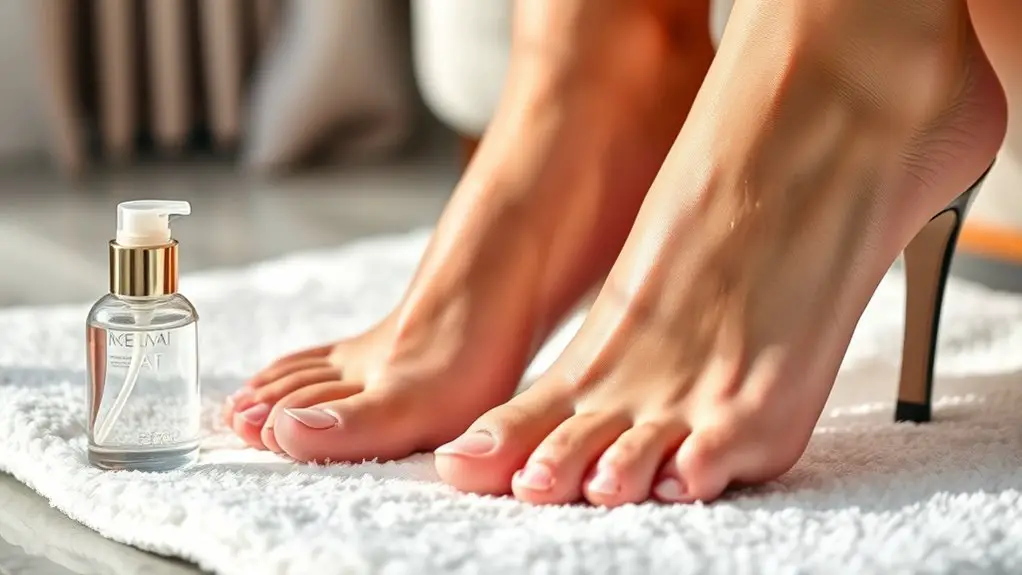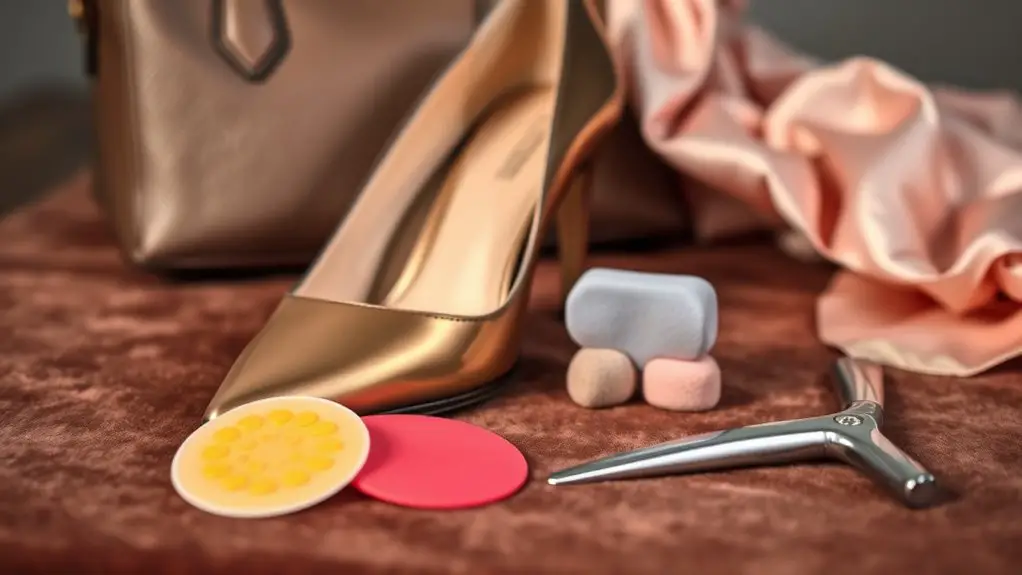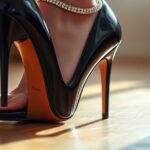To prevent blisters from high heels, start by choosing the right fit. Make sure your heels cradle your foot without being too tight, and allow toe movement. Invest in quality insoles for added support and cushioning. Break them in gradually by wearing them for short periods. Use blister prevention products like bandages or gels on areas prone to friction. Finally, keep your feet dry and moisturized to reduce irritation. Discover additional tips to enhance your comfort further.
Choose the Right Fit

When it comes to preventing blisters from high heels, choosing the right fit is essential. You’ll want to pay close attention to the heel shape and toe box of the shoes. A well-fitted heel should securely cradle your foot without being overly tight. Make sure the heel height is manageable, as excessive elevation can cause your foot to slide forward, leading to friction and blisters.
The toe box should provide ample space for your toes to move without feeling cramped. A narrow toe box can cause pressure points, increasing the likelihood of blister formation. It’s a good idea to try on shoes at the end of the day when your feet are slightly swollen, ensuring a more accurate fit. Remember, a comfortable fit can greatly reduce your chances of developing blisters, allowing you to enjoy wearing your favorite high heels without discomfort.
Invest in Quality Insoles
Investing in quality insoles can make a significant difference in your comfort while wearing high heels. Customized insoles provide tailored support, helping to distribute your weight evenly and reducing pressure points that can lead to blisters. These insoles are designed to fit the unique contours of your feet, ensuring a snug fit that enhances comfort throughout the day.
On the other hand, gel inserts offer additional cushioning, absorbing shock with each step you take. They can help alleviate discomfort caused by the height of your heels, allowing you to focus on your day rather than your feet. By choosing high-quality insoles, whether customized or gel, you’re proactively preventing friction and irritation, key factors in blister formation.
Ultimately, investing in the right insoles will enhance your overall experience in high heels, keeping your feet happy and blister-free.
Break Them In Gradually

Even with quality insoles, the way you wear your high heels matters. To prevent blisters, it’s essential to break in your shoes gradually. Start by wearing them for short periods around your home. This familiarizes your feet with the shoe’s fit and allows the material to stretch properly. If your high heels are particularly stiff, consider wearing socks with them during these initial try-ons. This technique helps stretch the shoes while providing extra cushioning, reducing friction against your skin.
Aim to increase the duration you wear them each day, slowly extending your time in the heels. Pay attention to any areas of discomfort, and if needed, use a shoe stretch spray to assist in loosening particularly tight spots. By taking your time and allowing your shoes to conform to your feet, you’ll greatly lower the risk of developing those painful blisters.
Use Blister Prevention Products
To effectively prevent blisters while wearing high heels, incorporating blister prevention products into your routine can make a significant difference. Start by using blister bandages, which provide a protective barrier against friction. These bandages are designed to adhere to your skin and cushion areas prone to blisters, reducing irritation throughout the day.
Additionally, consider applying friction-reducing products, such as gels or sticks, to areas that often experience rubbing. These products create a smooth surface, minimizing the chances of skin breakdown. It’s important to choose options that are specifically formulated for foot use, ensuring they’re safe and effective.
Before slipping on your heels, take a moment to apply these prevention products. You’ll not only enhance your comfort but also enjoy your time in high heels without the worry of painful blisters. With the right tools, you can step out confidently and stylishly.
Keep Your Feet Dry and Moisturized

Alongside using blister prevention products, keeping your feet dry and moisturized plays a key role in preventing blisters when wearing high heels. Moisture can lead to friction, which causes blisters, so it’s essential to manage that effectively. Start by investing in moisture-wicking socks that draw sweat away from your feet, helping to keep them dry throughout the day. Avoid cotton socks, as they tend to retain moisture.
Additionally, applying foot powder can help absorb excess moisture and reduce friction. Make it a habit to dust your feet with foot powder before slipping into your heels, ensuring a smoother fit. If your feet are already prone to dryness, consider using a good moisturizer after washing your feet to keep the skin supple. By maintaining dryness and hydration, you’ll greatly reduce the risk of blisters, allowing you to enjoy your high heels with confidence.
Frequently Asked Questions
Can Specific Heel Heights Reduce Blister Risks?
Isn’t it fascinating how heel height considerations play a vital role in blister prevention strategies? Lower heels generally reduce friction and pressure, minimizing your chances of blisters, while higher ones can increase discomfort and risk.
Are There Any Home Remedies for Blisters?
For blister prevention, you can try soothing treatments like aloe vera gel, tea tree oil, or honey. These remedies help reduce inflammation and promote healing, providing relief while your skin recovers from any friction or irritation.
How Often Should I Replace My High Heels?
You should replace your high heels regularly—ideally every six to twelve months. Proper heel maintenance can extend their lifespan, but once they start showing wear, it’s time to invest in a fresh pair for maximum support.
What Type of Socks Can Help With Blisters?
For blister prevention, consider wearing socks made from moisture-wicking materials like merino wool or synthetic blends. These fabrics reduce friction and keep your feet dry, substantially lowering the risk of blisters during wear.
Do Certain Foot Shapes Require Different Heel Styles?
Just like a painter needs the right brush, your foot anatomy dictates the heel design that suits you best. Different shapes require tailored styles to guarantee comfort, reducing pain and enhancing your overall experience in heels.



